Full Text Searchable PDF User Manual

analog and digital systems
P4 5 0 /P6 5 0 /P8 5 0
owners manual
00-3009 REV A
©2001 analog and digital systems, inc.
300 wildwood avenue, woburn, massachusetts 01801
781.729.1140 www.adst.com
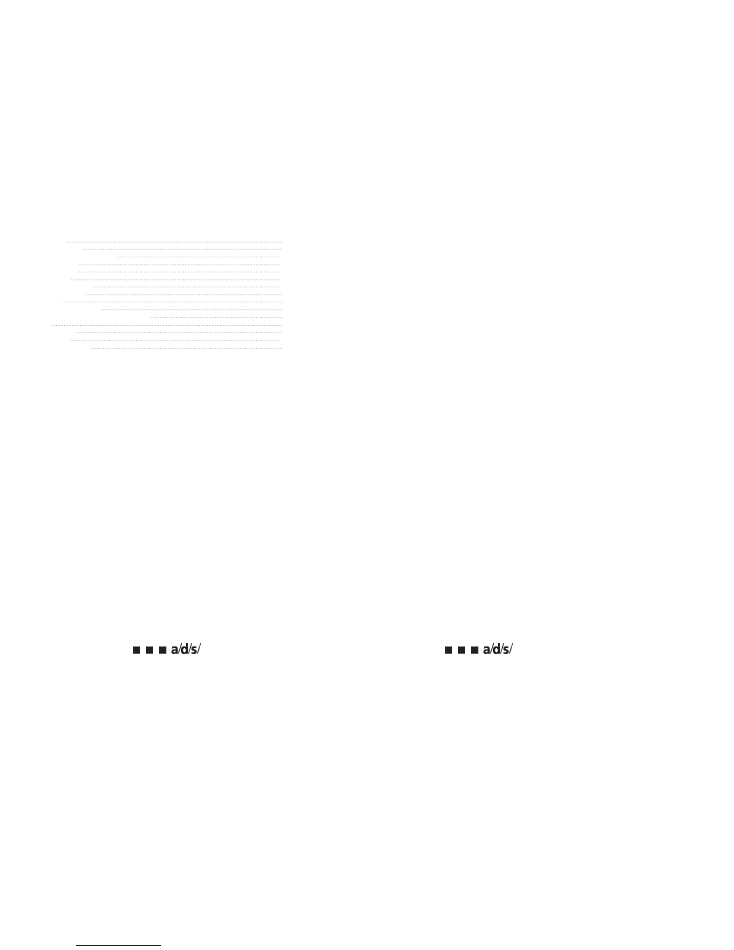
1
26
table of contents
introduction
1
about this manual
2
features of your PowerPlateTM
2
warning and tips
3
system planning
4
signal sources
4
system configurations
6
mounting locations
11
installation
12
controls and connections
13
multi-crossTM crossover and configurations
16
tuning
17
troubleshooting
19
specifications
21
warranty information
22
introduction
Although it may be hard to remember, back in the 1970’s, car audio as we now know it didn’t
really exist. Sure, music lovers could buy a cassette or 8-track tape deck and some 6" x 9"
three-way speakers. Advanced stereo buffs might even add a "power-booster" to increase output
to as much as 12 watts RMS! But none of this really delivered the power to cut through road
noise with sound quality that compared with the best home audio. Not until 1979 that is, when
a/d/s/ introduced the revolutionary PowerPlate
TM
P100 amplifier and 300i 2-way plate
loudspeakers. Aesthetically, the P100 introduced the low profile design which has been an a/d/s/
trademark to this day. Technologically, the P100 combined a high efficiency switching power
supply with a state-of-the-art, discrete high-cur rent stereo power amplifier. For the first time, a car
audio system existed with the musical integrity and dynamic range that made you want to take
long drives to nowhere, just to listen to the music. High quality car audio was born, and the
original a/d/s/ PowerPlate
TM
P100 made it happen.
The latest improvements to the PowerPlate
TM
line-up include increased heatsink area to facilitate
higher power output, and fully balanced high-level inputs compatible with any source. The
amplifier you have purchased is an enhancement of the respected P-series multichannel amplifiers.
In this version, we have improved upon the already acclaimed sound quality by addressing internal
details, and upgrading selected components to incorporate the latest technology which may not
have been available when the P-series was originally designed. Selected low-noise, high-speed
Burr-Brown op amps are used in critical circuits. Class-A biasing is used throughout the
voltage-gain and active crossover stages. Numerous modifications and "tweaks" were also
performed which improve the power supply dynamics and reduce noise. These changes improve
transparency and dynamic linearity, resulting in a smoother and more detailed top-end, tighter
bass, more explosive dynamic contrasts, and virtually holographic imaging. Left intact are the
P-series unequalled flexibility, high efficiency and superb reliability. These, along with multi-channel
design, are fundamental in the a/d/s/ approach to systems engineering, which makes achieving
true high fidelity reproduction simple and predictable in any installation.
warranty
There are two things you must do to ensure trouble free service in the event you need warranty repairs.
1. Keep your original sales receipt in a safe place. A copy of the receipt will be required to obtain
warranty service.
2. Be sure your retail dealer has written the date, model number and serial number (if applicable) of the
product on the receipt. To give yourself an extra measure of protection, make a separate record of
the information about your purchase and keep it in a safe place. In the event you misplace the sales
receipt, your dealer may be able to give you a copy.
Take a moment now to read the terms of your warranty. Check to be sure your sales receipt is dated
and has the product model number and serial number (if applicable) on it. Then put it away in a safe
place.
When shipping a Product in for service:
• Enclose a copy of your original sales receipt that has the date, product model number and serial
number (if applicable) written on it.
• Always ship Products in the complete original packing material.
• Avoid shipping Products via the postal service. If you must use the postal service, be sure to register
and insure the package.
a/d/s/ Limited Warranty
Analog and Digital System, Inc. (a/d/s/) warrants to the original consumer purchaser of the a/d/s/ Prod-
ucts described in this manual, that the Product will be free from defects in materials and
workmanship for a period of one (1) year after the date of purchase, if the Product is installed by an
authorized a/d/s/ retail dealer, the warranty is extended to three (3) years. a/d/s/’ sole obligation under
the warranty shall be to provide, without charge, parts and labor necessary to remedy the defects, if
any, that appear during the warranty period.
This warranty is the sole and exclusive express warranty given with respect to the Product. All other
express warranties are hereby excluded. Neither a/d/s/ nor the authorized dealer who sells the Product is
responsible for indirect, incidental, or consequential damages. Some states do not allow the exclusion
or limitation of incidental or consequential damages, so the above limitation or exclusion may not apply
to you. This warranty gives you specific legal rights and you may also have other rights which vary from
state to state.
IMPORTANT
– Keep your original sales receipt. Be sure the retail dealer has written on it the date,
model number and serial number (if applicable) of the Product. This information is required for warranty
service.
This warranty is limited to:
• Products purchased from authorized a/d/s/ retail dealers in the United States. a/d/s/ will supply a list of
authorized dealers on request.
In order to obtain warranty service you must:
• Return the Product, freight prepaid, to the a/d/s/ dealer from which it was purchased, an authorized
a/d/s/ independent service agency, or to a/d/s/. If necessary you may call the a/d/s/ Customer Service
Department for the names and addresses of authorized independent service agencies in your area.
• Provide proof of purchase in the form of a copy of your original sales receipt. The date, model num
ber and serial number (if applicable) of the Product must be written on the sales receipt.
This warranty does not cover:
• Damage that is the result of misuse, abuse, accident (including but not limited to damage by water),
faulty hookup, defective or maladjusted associated equipment, or the use of the Product with equip
ment of which it was not intended.
• Cosmetic defects that appear more than thirty (30) days after the date of purchase. Cosmetic damage
caused by improper handling is also excluded.
• Products that are used for commercial purposes.
• The cost of removing or reinstalling the Product.
• Damage that occurs while the Product is being shipped to whoever will service it. See the information
above regarding shipping procedures.
This warranty is void if:
• The Product identification or serial number is removed or defaced in any way.
• The Product is serviced or repaired by anyone other than a/d/s/ or an authorized a/d/s/ dealer or
service agency.

25
2
specifications
amplifier section
power output 4
W
(watts)
1
50/channel 150/bridged channel pair
power output 2
W
(watts)
2
75/channel
distortion all channels driven 0.1%
20Hz to 20,000Hz
frequency response ±1dB
10Hz to 30,000Hz
signal-to-noise ratio full
bandwidth @ rated output power
>90dB
damping factor @ output
connector full bandwidth
>150
input sensitivity
100mV to 8Vrms for full output
input impedance
47 k
W
recommended fuse type
P850
2 X 40 ATC
P650
2 X 30 ATC
P450
1 X 40 ATC
crossover section
3
ch 1 & 2
high-pass
ch 3 & 4
high-pass & low-pass
ch 5 & 6
high-pass & low-pass (P850), low-pass (P650)
ch 7 & 8
low-pass
dimensions
P850
13" X 2" X 16 1/8" (330mm X 50mm X 410mm)
P650
13" X 2" X 141/8" (330mm X 50mm X 359mm)
P450
13" X 2" X 11 1/8" (330mm X 50mm X 283mm)
1 All channels driven, continuous FTC rated 4
W
load, 20Hz to 20,000Hz, <0.1% THD,
power input voltage at 13.8DVC.
2 All channels driven, continuous FTC rated 2
W
load, 20Hz to 20,000Hz, <0.1% THD,
power input voltage at 13.8DVC.
3 All channels are selectable with infinitely variable adjustments from 45Hz to 5,000Hz
with a slope rate of 12dB/octave and a "Q" of .707.
about this manual
To get the most from your a/d/s/ PowerPlate
TM
, we recommend that you have the installation
performed by your qualified authorized a/d/s/ dealer. If this unit is installed by your dealer, we will
extend the warranty to three years instead of the standard one year. However, if you feel that you
have the necessary skills and prefer to perform the installation yourself, this manual will guide you
through the process of installation and set-up. Please read through it completely before beginning
the installation so that you may familiarize yourself with the total procedure before you begin. If
there is anything that you do not fully understand, please consult with your a/d/s/ dealer before
attempting the installation.
keep listening, but be safe!
Sustained listening to loud music over 100dB has been shown to cause permanent hearing dam-
age. Systems using a/d/s/ components are capable of achieving volume levels which substantially
exceed this level. When operating your system for sustained periods at high volume, be sure to
use hearing protection to prevent long-term exposure. We want you to be able to enjoy the music
for many more years.
features of your PowerPlate™
Transient Perfect
TM
MOSFET Power Supply
– The heart of the P-series, this supply frees the
PowerPlate
TM
from the constraints of common pwm (pulse width modulated) supplies. The advan-
tages are: extremely fast overload recovery time, low output
mpedance for superior damping, and stability during voltage fluctuations for reliable performance
in the harsh automotive environment.
Remote Subwoofer Control Capability
– Can be used with accessory control AC502 to provide
a dashboard mounted subwoofer or rear channel level control
Detachable Plug in Connectors
– High current speaker and power connectors
simplify installation.
Multi-cross
TM
Variable Built-in Crossovers
– High-pass, Low-pass and Bandpass functions are
built-in, virtually eliminating the need for external crossover networks in even the most elaborate
systems.
PowerPlate
TM
Design
– a/d/s/ original low profile, high efficiency heatsink design keeps size mini-
mum and allows mounting where space is limited.
Wide Input Sensitivity Range
– Allows connection to virtually any source unit from factory OEM
radios through low output preamps.
Simultaneous Stereo and Mono
– Each channel pair may be used Stereo, Mono, Bridged or
both Stereo and Mono simultaneously. This allows an additional Mono speaker to be used with a
stereo pair for center-channel or subwoofer applications from each channel pair.
Same Side Adjustments
– The P-series PowerPlate
TM
makes system adjustment easy by
organizing all signal processing controls on one side of the amplifier. This layout allows convenient
system adjustment and facilitates a variety of installation possibilities when access to the controls is
desired.
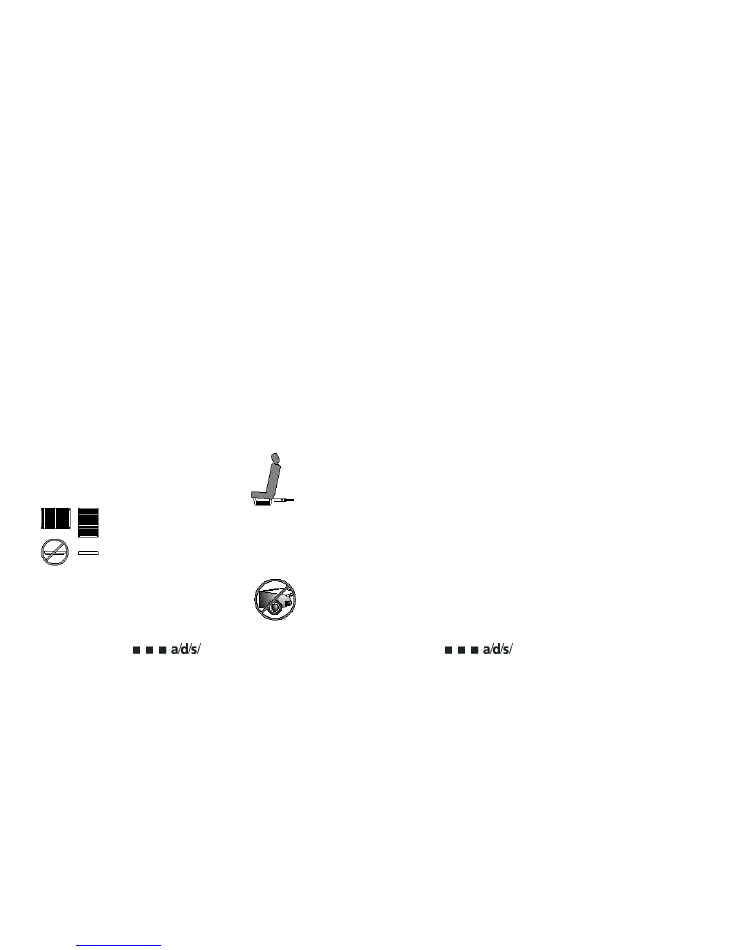
3
24
Warnings and tips
Always disconnect the battery ground wire before doing any work on your vehicle. Reconnect the
cable only after the installation is complete and the wiring has been checked to make sure that
there are no problems. If your radio features a code type security system, be sure you know the
code before disconnecting the battery!
Your a/d/s/ PowerPlate
TM
should be installed in 12V negative ground vehicles only. Connection to
other types of electrical systems may cause damage to the vehicle or the amplifier.
Wear Eye and Ear protection when using power tools.
Before cutting or drilling carefully inspect the area to make sure there is no electrical wiring, fuel
lines or brake lines which could be damaged. Sometimes these components may be hidden
between double-walled panels, so be very careful.
Do not bypass or modify the fuses, or replace with one of a higher rating. The fuse should not fail
under normal operation. Repeated blowing indicates a problem with the amplifier or improper
installation.
An additional power supply line fuse (not supplied) must be installed on the 12V supply line and
located as close as possible to the battery in order to protect the wire in the event of a short
circuit.
Make sure the system is turned off when making or breaking any connections.
Do not use your PowerPlate
TM
with speakers which have either terminal connected to the speaker
frame or to the vehicle chassis.
symptom
possible cause
action to take
distorted output (cont’d)
speakers are blown
check system with known
working speakers and repair or
replace as needed
poor bass response
Speakers wired with wrong
check speaker polarity and
polarity causing cancellation
repair as needed
at low frequencies
crossover set incorrectly
reset crossovers referring to the
multi-cross
TM
crossover
configuration section of this
manual for detailed instructions
battery fuse blowing
impedance load to amplifier
check speaker impedance load,
too low
if below 2
W
stereo or 4
W
mono
rewire speakers to achieve a
higher impedance
short in power wire or incor rect
check power and ground
power connections
connections and repair as
needed
fuse used is smaller than
replace with proper fuse size
recommended
too much current being drawn
check speaker impedance load,
if below 2
W
stereo or 4
W
mono
rewire speakers to achieve a
higher impedance
check power and ground
connections and repair as
needed
amplifier fuse blowing
too much current being drawn
Check speaker impedance load,
if below 2
W
stereo or 4
W
mono
rewire speakers to achieve a
higher impedance and replace
with recommended fuse size
check power and ground
connections and repair as
needed
fuse used is smaller than
replace with proper fuse size
recommended
Mounting locations
PowerPlate
TM
in a place that protects it from the elements. In addition, mount the PowerPlate
TM
on
a stable, flat mounting surface. Whenever possible, pre-drill the mounting holes. Remember to
check behind the panel for hidden dangers in the form of hoses, fuel or brake lines or electrical
wiring. Use a marking pen or awl to mark the hole locations and pre-drill using a 1/8" bit.
Passenger compartment mounting
All PowerPlates
TM
have been designed with a low profile to make under
seat mounting possible. Regardless of where you choose to mount your
PowerPlate
TM
be sure to keep a minimum of 1" of clearance around the
amplifier for adequate airflow to prevent overheating.
Trunk compartment mounting
The most common mounting location is in the
trunk or cargo compartment. For optimum cooling, mount the Power-
Plate
TM
chassis vertically with the fins running vertically, or mount the
PowerPlate
TM
horizontally with the fins pointing upward. Avoid horizon -
tal mounting locations with the fins pointing downward.
Also, locate the PowerPlate
TM
where it, and connections to it, will not be
damaged by cargo or tools which may shift during vehicle operation.
Engine compartment mounting
Don’t even think about it! The PowerPlate
TM
was not designed to endure the
harsh chemical and heat environment of the engine compartment. Failure to
obey this warning will void your warranty.
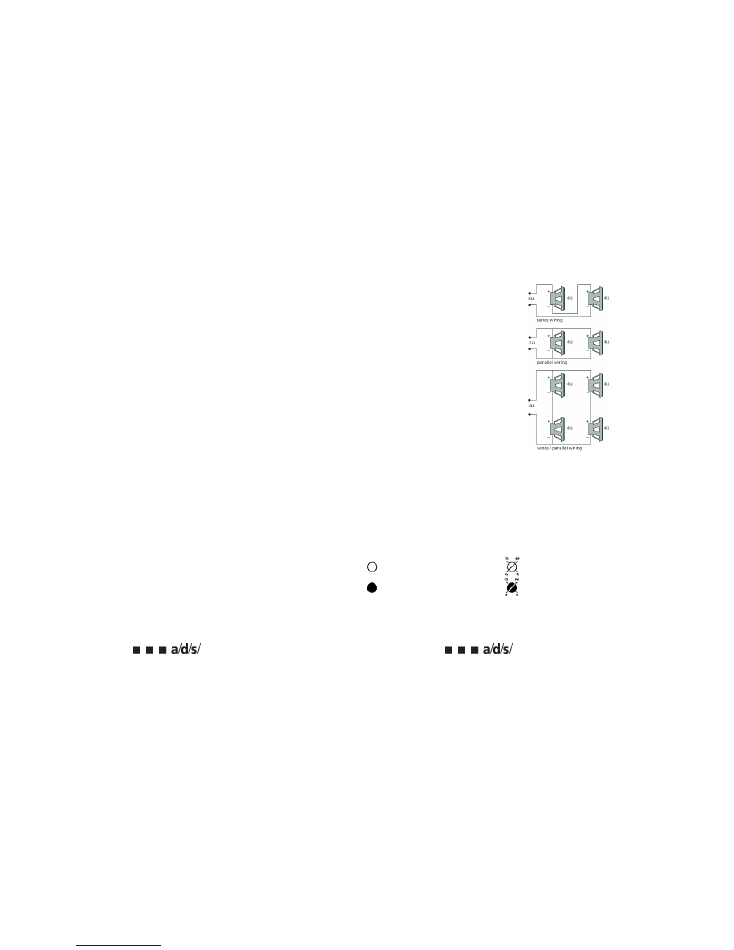
23
4
Troubleshooting
symptom
possible cause
action to take
no output
low or no remote turn-on input check remote turn-on voltage
output at amplifier and correct
as needed
fuse blown
check power wire integrity
and reversed polarity, repair
as needed and replace fuse
power wires not connected
check power wire and ground
connections and repair or
replace as needed
audio input not connected or
check input connections and
no output from source
signal integrity, repair or
replace as needed
speaker wires not connected
check speaker wires and repair
or replace as needed
audio cycles on and off
speakers are blown
check system with known
working speaker and repair or
replace speakers as needed
thermal protection engages
make sure there is proper
when amplifier heatsink
ventilation for amplifier and
temperature exceeds 90° C
improve ventilation as needed
loose or poor audio input
check input connections and
repair or replace as needed
distorted output
amplifier level sensitivity set too reset gain referring to the
high; exceeding maximum
tuning section of the manual
output capability of amplifier
for detailed instructions
impedance load to amplifier too check speaker impedance load
low
if below 2
W
stereo or 4
W
mono rewire speakers to
achieve a higher impedance
shorted speaker wires
check speaker wire
connections and repair or
replace as needed
speaker not connected to
check speaker wiring and
amplifier properly
repair or replace as needed
refer to the installation section
of this manual for detailed
instructions
internal crossover not set
reset crossovers referring to the
properly for speaker
multi-cross
TM
crossover
configuration section of this
manual
system planning
Proper system planning is the best way to maximize your PowerPlate
TM
’s performance. By planning
your installation carefully you can avoid situations where the performance or the reliability of your
system is compromised. Your authorized a/d/s/ dealer has been trained to maximize your
system’s sonic potential. Your a/d/s/ dealer is a valuable resource in helping you with your system
design and installation.
speaker requirements
Each channel of your PowerPlate
TM
can easily drive 2
W
speak-
er loads when used in the stereo mode. When a channel-pair
is bridged, the recommended minimum load impedance is
3
W
for subwoofer use, and 4
W
for full range operation.
Although operation with lower impedances is not likely to
cause immediate damage to the internal circuitry, the unit
will most likely overheat, causing the thermal protection cir-
cuitry to shut down the amplifier. When the chassis cools
down, normal operation will resume. Continuing to operate
the amplifier under these conditions is not recommended
and will reduce its life expectancy.
Most speakers designed for car audio operation are 4
W
impedance. Connecting two such speakers in parallel will
result in a 2
W
impedance load as seen by the amplifier. Some a/d/s/ sub-
woofer models feature a dual 4
W
voice coil design. Connect-
ing these voice coils in parallel will result in a 2
W
nominal
impedance which is not recommended for use with bridged
channels of your PowerPlate
TM
.
system configurations
All a/d/s/ PowerPlates
TM
provide extensive features which make a variety of system configurations
possible. It is not feasible to cover all of the possibilities within the few pages of this manual.
There are a few system configurations, however, which are extremely popular when used alone or
as a "building block" of a larger more elaborate system. Please review systems 1 through 4
described below for suggestions on how to configure the most popular combinations. Larger
systems may be built from a combination of the simpler building blocks as shown in systems
5 and 6.
button is disengaged
control is non-operational
control is operational
button is engaged
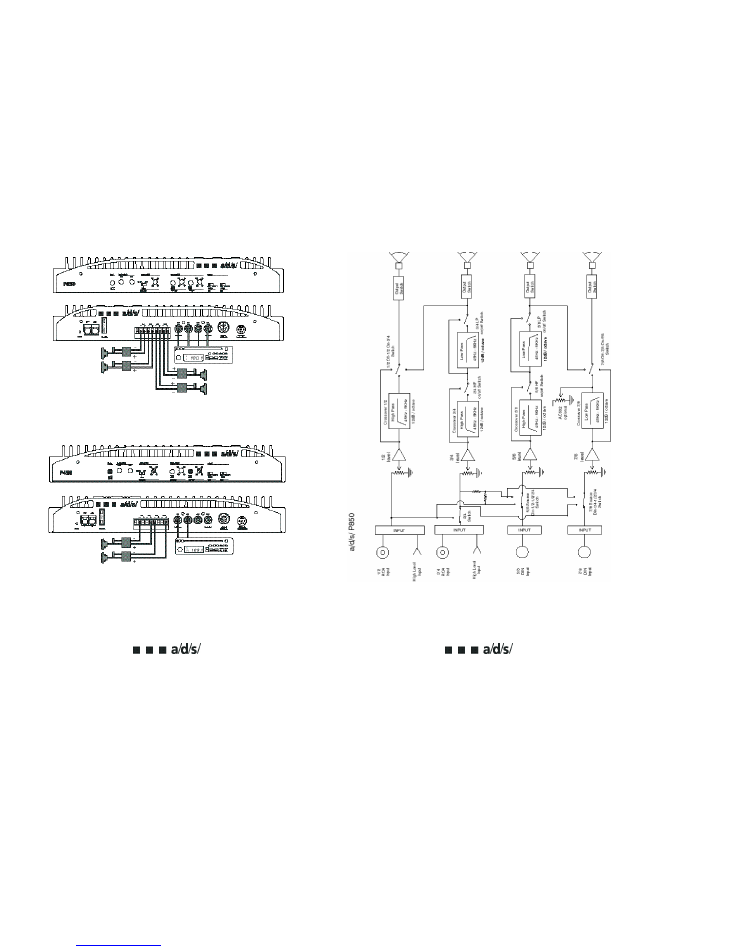
5
22
P450 system diagrams
System 1
- P450 used in 4-channel mode with front and rear full range speakers.
System 2
- P450 used in 2-channel bridged mode with full range speakers.
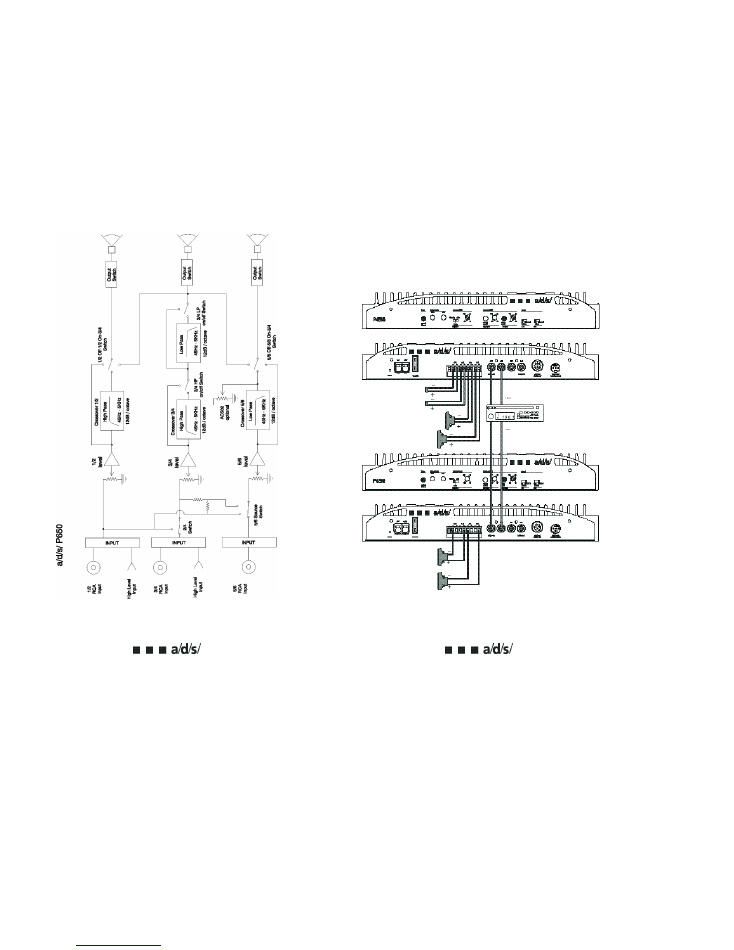
21
6
System 3
- Two P450’s; one is used to drive front tweeters and midrange drivers, the second is
used in 2-channel bridged mode for subwoofers. Subwoofer level can be controlled by using the
source’s front output for the first P450 and the rear output for the second P450.
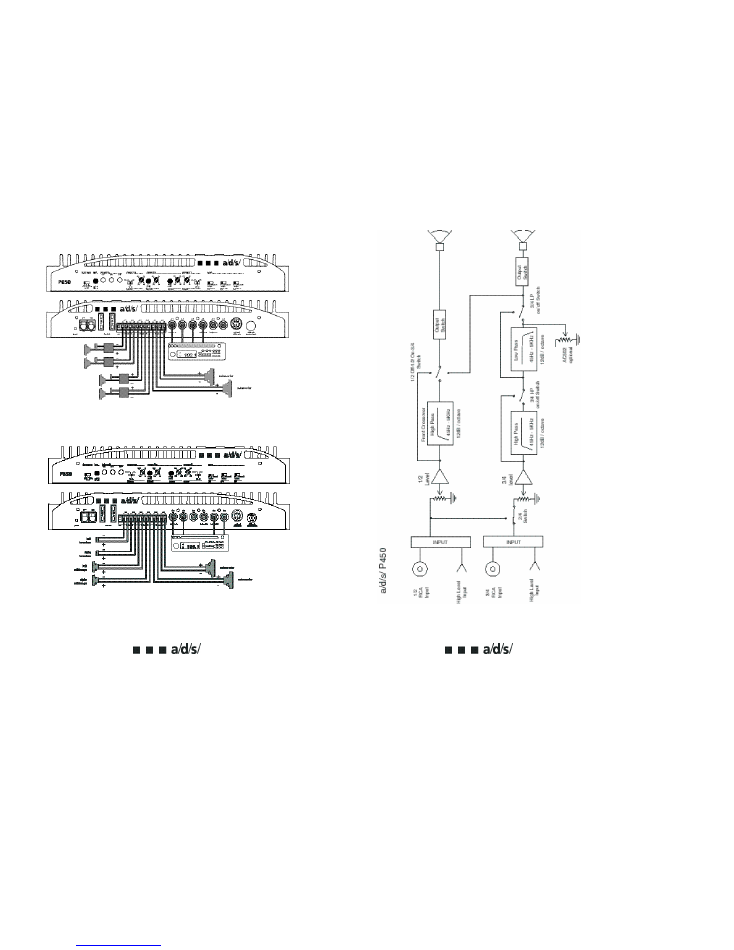
7
20
System 1
– P650 used in 6-channel mode. Channels 1/2 are high-passed for front speakers. Chan-
nels 3/4 are high-passed for rear speakers. Channels 5/6 are low-passed for subwoofers. Although
shown with 4-channels of input, the source unit can be either 2- or 4-channel.
System 2
– P650 used in 6-channel mode. Channels 1/2 are high-passed for front speakers. Chan-
nels 3/4 are high-passed for midrange speakers, and channels 5/6 are low-passed for subwoofers.
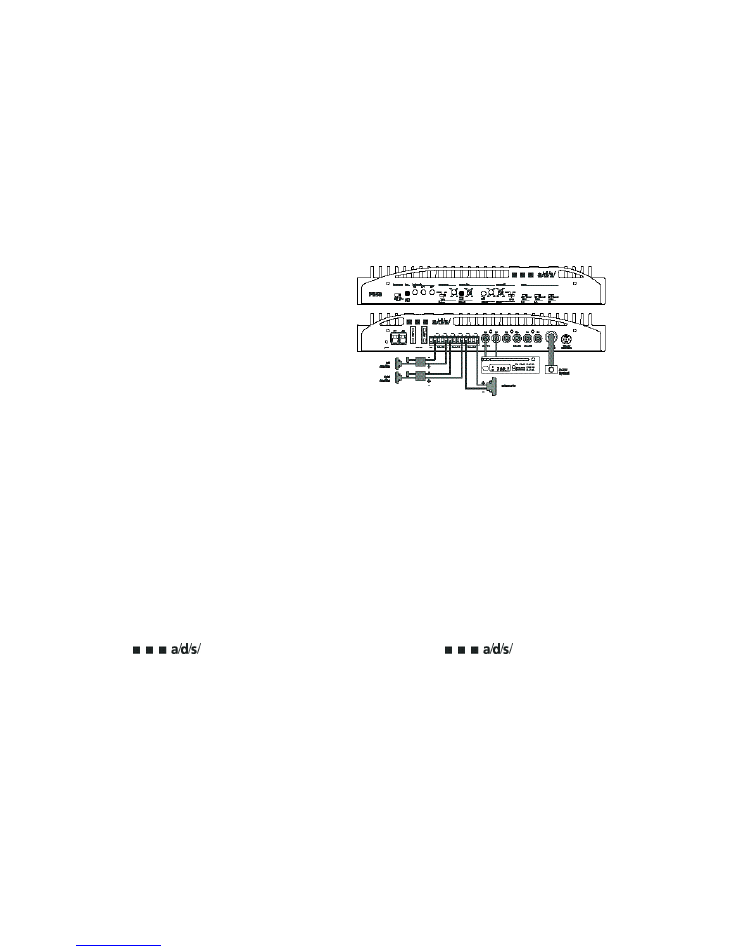
19
8
adjusting input sensitivity
The input sensitivity setting is important to ensure proper performance, low noise levels, and maxi-
mum system reliability. As a general rule, components at the "front end" of the system should be
set as high as possible with the input sensitivity of the amplifier set as low as possible while still pro-
viding adequate volume levels. Using a high signal level from the source and a low input sensitivity
setting on the amplifier will keep the background noise levels of the system low. The following pr o-
cedure will help you get the widest dynamic range from your system:
1.
Start with the input level controls of your PowerPlate
TM
at the minimum (counterclockwise)
position.
2.
Set the tone controls and any controls on any equalizers or other signal processors to their
flat or bypassed positions.
3.
Set the input and output level controls, if any, on any associated equipment such as equalizers
or outboard electronic crossover as recommended by their manufacturers.
4.
Select a well recorded CD or Tape containing material recorded at a fairly high level. Musical
content is not important except that the music chosen should be recorded such that any
system distortion can be clearly heard, not masked by musical content.
5.
Increase the source unit volume control about halfway. Increase the PowerPlate
TM
level control
associated with the front full range (or midrange in a bi-amplified front system) until you can
hear sound at a low but clear level.
6.
While listening carefully for any signs of distortion, slowly increase the source unit volume cont
rol until you either hear the first signs of distortion or you can’t turn it up any more. Back down
on the volume control slightly until the distortion goes away. You have just found the maximum undis-
t o rted output level of your source unit. Do not exceed the level in normal operation, as doing so will just
send a distorted signal to the rest of the system.
7.
Returning to the PowerPlate
TM
level control associated with the front main speakers, slowly
increase it until you reach the point where distortion just begins to appear. This will be at the
point where either the amplifier reaches its maximum output level, or the speakers reach their
output limits. Either way, you have just calibrated the system so that the maximum system out
put occurs at the same point as the maximum output from the source. This will give you min-
imum system noise yet the system will reach its maximum output capability.
8.
Reduce the source unit volume to a comfortable listening level. With the balance and fader
controls still centered, adjust the remaining level controls for the proper system balance. If you
are adjusting a system with multiple amplifiers, it is easiest to adjust the controls in the fol-
lowing order: 1. Front speakers 2. Rear speakers 3. Subwoofers
9.
If using an AC502 remote level control, adjust the subwoofer level with the AC502 in the mid
position. This will give you the ability to boost the subwoofer level approximately 6dB when
the AC502 is turned fully clockwise.
10. Double check your system levels by increasing the source unit volume control to the previous
ly determined maximum position. If you hear distortion from any of the channels, reduce the
PowerPlateTM input level for those channels until the distortion goes away.
Adjusting the input levels in this way will get maximum undistorted output from your system
and will make it unlikely that you will cause damage to any of the components of your system
by overpowering them.
System 3
– P650 used in 3-channel mode. Channels 1/2 and 3/4 are high-passed and bridged for
front speakers. Channels 5/6 are low-passed and bridged for a single subwoofer.

9
18
P850 system diagrams
System 1 – P850 used in 6-channel mode. Channels 1/2 are high-passed for front speakers chan-
nels 3/4 are high-passed for rear speakers, and channels 5/6 and 7/8 are bridged low-pass for sub-
woofers. Although shown with 4-channels of input, the source unit can be either 2- or 4-channel.
System 2
– The P850 is used in 8-channel mode. Channels 1/2 are high-passed for front tweeters.
Channels 3/4 are band-passed for front midrange. Channels 5/6 are high-passed for rear speakers,
and channels 7/8 are low-passed for subwoofers. Although shown as a 4-channel input, the
source unit can be either 2- or 4-channel.
Using the AC502 (optional)
The AC502 remote level control, available as an accessory from your a/d/s/ dealer, may be used with
your PowerPlate™ to remotely adjust the level of your subwoofer. On the P450, the AC502 will con-
trol the level of the low-pass output of the 3/4 crossover. If the 1/2 crossover switch is in the 3/4 posi-
tion the 1/2 level will also be controlled. You can use P450 as a bridged two channel subwooofer
amplifier this way. On the P650 the AC502 will control the level of the low-pass output of the 5/6
crossover. On the P850 the AC502 will control the level of the low-pass output of the 7/8 crossover.
To use this feature, simply connect the AC502 into the DIN connector on the Powerplate and install
the AC502 in the desired location. Refer to the "adjustments" section for information on setting up
the AC502 for the appropriate adjustment range.
tuning
tuning the crossover
All of the crossover controls in the multi-crossTM crossover section are marked at
four reference frequency points. These are 45Hz, 175Hz, 600Hz and 5,000Hz. Spe-
cific crossover points should be chosen based on the operating range recommended
by the manufacturer of your speakers.
The 85Hz position is a good starting point to use for subwoofer low-pass or
midrange high-pass use. When bi-amping a/d/s/ loudspeaker components 2500Hz is
a good starting point for the midrange low-pass, and 3500Hz is recommended as the tweeter high-
pass. Once installed, you can fine tune the crossover points using your ears or with the aid of an RTA
to achieve maximum performance. With any loudspeaker, minor deviations from the recommended
frequency ranges may provide superior results, depending on your speaker locations and your vehi-
cle’s acoustics. Setting crossover frequencies higher than recommended will not cause damage and
may provide good results. However, DO NOT set high-pass tweeter crossover points below the
tweeter’s recommended operating range. Doing so will likely cause damage not covered by the man-
ufacturer’s warranty. If you are using non-a/d/s/ speakers, refer to the manufacturer’s recommenda-
tion for selecting the proper crossover frequencies.
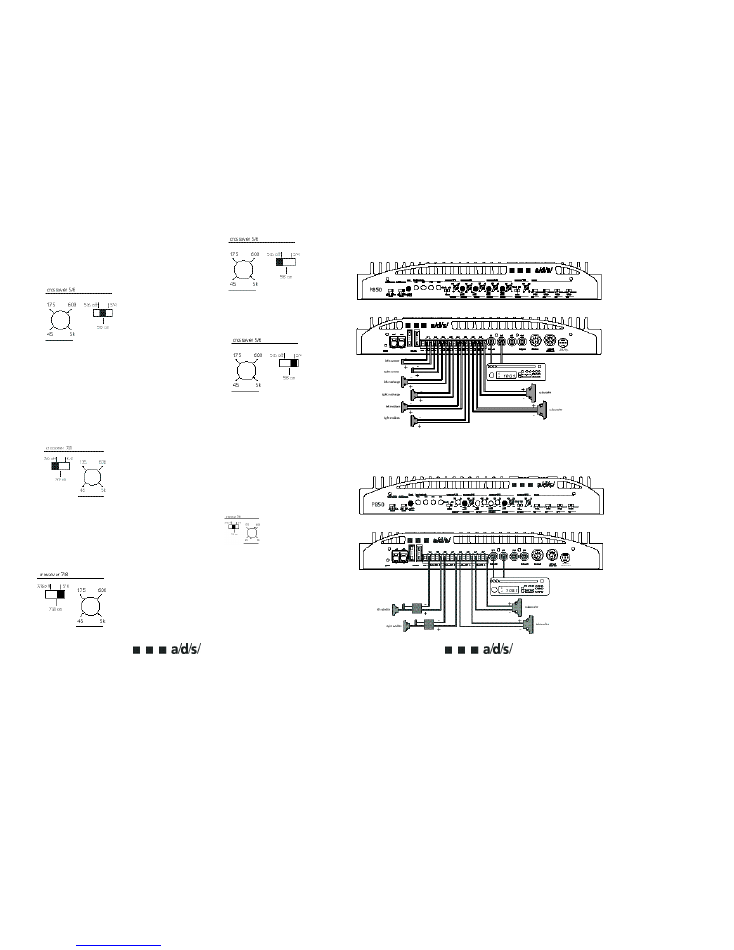
17
10
xover control 5/6 (P650)
– The crossover selection for channels
5&6 has three possibilities:
When the switch is in the left position, the crossover section of the
amplifier is bypassed. Channel 5&6 output is full range.
When the switch is the center position, channels 5&6 are filtered
through a 12dB per octave high-pass crossover that is infinitely
variable from 45Hz to 5,000Hz.
When the switch is in the right position, channels 5&6 receive signal
from the crossover output of channels 3&4.
xover control 7/8
– The crossover selection for channels 7&8 has
three possibilities:
When the switch is in the left position, the crossover section of the
amplifier is bypassed. Channel 7 & 8 output is full range.
When the switch is the center position, channels 7 & 8 are filtered
through a 12dB per octave high-pass crossover that is infinitely
variable from 45Hz to 5,000Hz.
When the switch is in the right position, channels 7 & 8 receive signal
from the crossover output of channels 5 & 6.
System 3 – The P850 is used in fully active 8-channel mode. Channels 1/2 are high-passed for
front tweeters. Channels 3/4 are bandpassed for front midrange. Channels 5/6 are bandpassed for
front midbass. Channels 7/8 are low-passed for subwoofers. The P850 is configured for 2-channel
input.
Note: Optional AC502 can be used in this system to adjust the level of the subwoofers.
System 4
– The P850 is used in bridged 4-channel mode. Channels 1/2 and 3/4 are high-passed
bridged-mono for front speakers. Channels 5/6 and 7/8 are low-passed summed bridged for sub-
woofers. Front speaker level control is adjusted by the ch3/4 level control. Subwoofer level is con-
trolled by the ch5/6 level control. the P840.2 is configured for 2-channel input.
Note: Optional AC502 can be used in this system to adjust the level of the subwoofers.
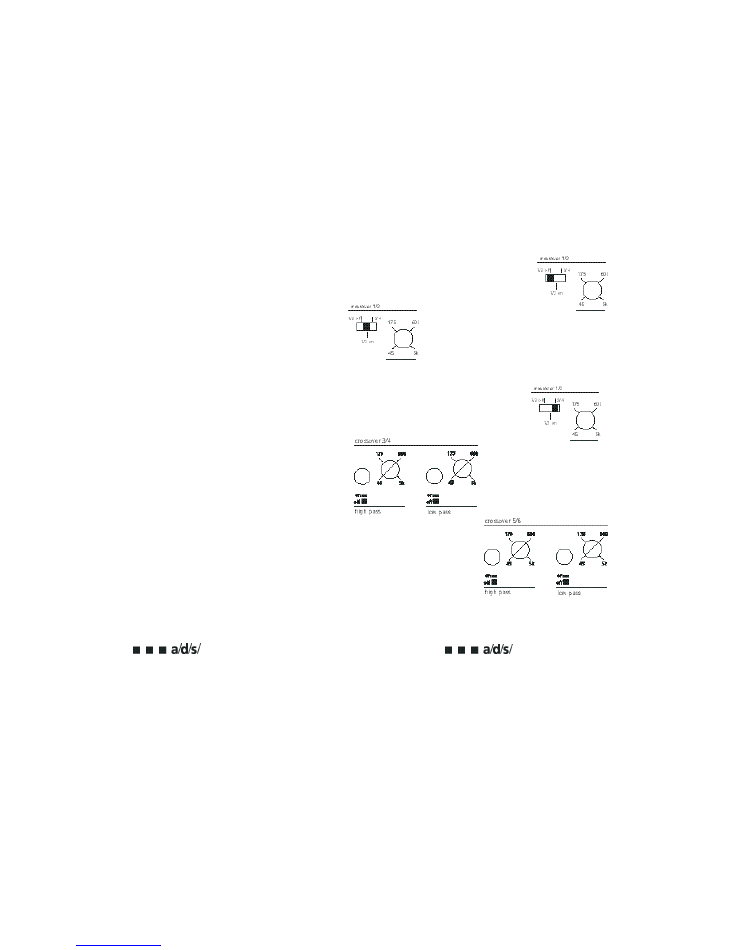
11
16
installation
1. Disconnect the battery ground cable. Reconnect the ground cable only after the installation is
complete and the wiring has been checked to make sure that there are no problems. If your
radio features a code type security system, be sure you know the code before disconnecting
the battery!
2. Run a minimum AWG #8 power wire directly from the battery to the PowerPlate™ mounting
location. Install a fuseholder at the battery end of this cable either within 18" of the battery
or before the wire runs through any metal partitions. Do not install the fuse at this time.
3. Attach a minimum AWG #8 ground wire to a solid chassis ground point near the mounting
location. Keep this wire as short as possible. Scrape all paint and primer off of the sheet
metal at the ground point to ensure a good electrical connection. Attach the wire to the
ground point with a nut, bolt and star washer.
4. Run the signal leads and remote turn-on leads from the head unit to the PowerPlate™ loca
tion. If using an internally powered radio or factory radio refer to the "signal sources" sec
tion for the proper wiring connections.
5. Install the speakers and run each of the speaker leads to the PowerPlate™ location. Connect
the speaker, remote, and power wires to the appropriate terminals on the plug-in terminal
blocks. Refer to the "controls and connections" or "system planning" sections for informa
tion on the proper connections. The terminal blocks install with the set screws facing down.
6. Preset the 2/4 channel selector switch, crossover and channel mode switches, and crossover
frequency switches to the desired positions. Refer to the "controls and connections" section
for more information.
7. Adjust all amplifier input level controls to the 1/4 position.
8. Mount the amplifier into position and plug in the power and speaker terminals. Attach the
input signal cables.
9. Reattach the battery ground cable.
10. Double check your switch and control settings. Install a 80A fuse in the fuseholder you have i
nstalled near the battery.
11. Turn on the signal source at a low volume level. Using the balance and fader controls, check
to see that each channel is connected to the proper speakers. Make sure that the proper fre
quency range is being sent to each speaker if you are using the crossover features built in to
your PowerPlate™.
12. Adjust the input sensitivity and crossover frequencies as described in the "tuning" section.
13. Read the rest of this manual to get maximum enjoyment from your system.
controls and connections
power connections
Use AWG #8 or larger power and ground cable.
Install a 80A fuse in the power wire within 18" of the battery.
Keep the ground wire to a minimum length and attach solidly to a clean metal part of the vehicle.
The addition of a .5 Farad to 1 Farad power supply capacitor, mounted as close as possible to the
PowerPlate™, may improve performance in some systems.
multi-cross
™
crossover configuration
xover control 1/2
– The crossover selection switch for channels 1 & 2 has three possibilities:
When the switch is in the left position, the crossover section of the
amplifier is bypassed. Channels 1 & 2 output is full range.
When the switch is the center position, channels 1 & 2 are filtered
through a 12dB per octave high-pass crossover that is infinitely vari-
able from 45Hz to 5,000Hz.
When the switch is in the right position, channels 1 & 2 receive
signal from the crossover output of channels 3 & 4.
Note: When the switch is in the right position, the output
level is controlled by the ch 3/4 level control.
xover con-
trol 3/4
– The crossover section dedicated for
channels 3 & 4 are activated by depressing the
switch next to each frequency adjustment con -
trol. Both high-pass and low-pass crossovers
are infinitely adjustable from 45Hz to 5,000Hz.
The high-pass and low-pass sections may be
used individually or together to create a band-
pass filter.
xover control 5/6 (P850)
– The crossover sec-
tion dedicated for channels 5 & 6 are activated
by depressing the switch next to the frequency
adjustment control. Both high-pass and low-pass
crossovers are infinitely adjustable from 45Hz to
5,000Hz. The high-pass and low-pass sections
may be combined to create a bandpass filter.
Note: When using both sections to create a bandpass filter, make sure you have selected
a low-pass frequency which is higher than the high-pass frequency!
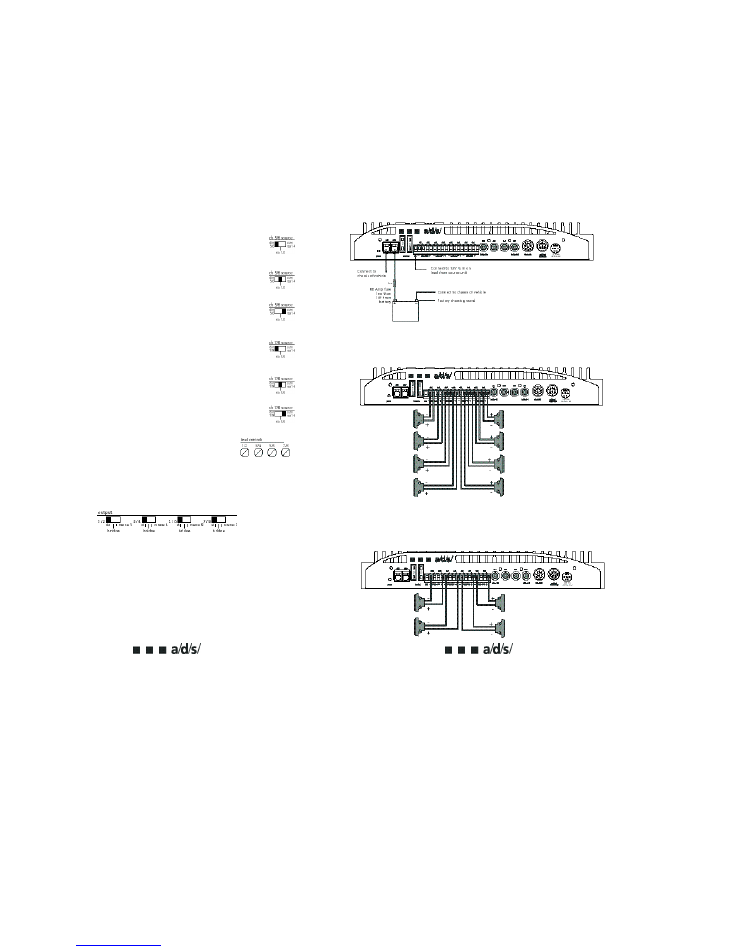
15
12
internal signal routing, cont’d
Channels 5/6 input switch (P650 and P850)
– selects input from three possibili-
ties.
When the switch is in the left position, channels 5/6 receive input from the 5/6 DIN
inputs.
When the switch is in the center position, channels 5/6 receive input from channels
1/2 RCA input.
When the switch is in the right position, channels 5/6 receive input from a summed
input of channels 1, 2, 3, and 4 RCA input. Channel 5 receives the summed input
of channels 1 and 3. Channel 6 receives the summed input of channels 2 and 4.
Channels 7/8 input switch (P850)
– selects input from three possibilities.
When the switch is in the left position, channels 7/8 receive input from the 7/8 DIN
inputs.
When the switch is in the center position, channels 7/8 receive input from channels
3/4 RCA input.
When the switch is in the right position, channels 7/8 receive input from a summed
input of channels 1, 2, 3, and 4 RCA inut. Channel 7 receives the summed input of
channels 1 and 3. Channel 8 receives the summed input of channels 2 and 4.
Level controls
– Independent level controls for channels 1/2, 3/4,
5/6 and 7/8 adjust the input sensitivity from 90 mV to 5 VRMS.
Note:
When crossover 3/4 output is selected for channels 1/2 and 3/4,
the 3/4 level control adjusts the output level for channels 1/2 and 3/4 simultaneously. When
crossover 5/6 is selected for channels 5/6 and 7/8, the 5/6 level control adjusts the output level for
channels 5/6 and 7/8 simultaneously.
Output
– Three-position switches determine the output configuration. Each stereo pair of chan-
nels can be configured in either stereo, summed-bridged or bridged-mono.
When the switch is in the left position, the output channels are configured for stereo operation.
When the switch is in the center position, the output channels are configured for summed mono
bridged operation by mixing the left and right input signals together.
When the switch is in the right position, the output channels are configured for a bridged-mono
output using a single RCA input. Ch 1 input is used for channels 1 & 2, ch 4 input is used for
channels 3 & 4, ch 6 is used for channels 5 & 6 and ch 7 is used for channels 7 & 8.
speaker connections for stereo configurations
Minimum recommended impedance is 2
W
stereo.
Speaker terminals accept up to AWG #12 speaker wire.
speaker connections for bridged configurations
Minimum recommended impedance is 3
W
when bridged to subwoofers and 4
Wv
when bridged to
full range speakers.
Speaker terminals accept up to 12 gauge speaker wire.
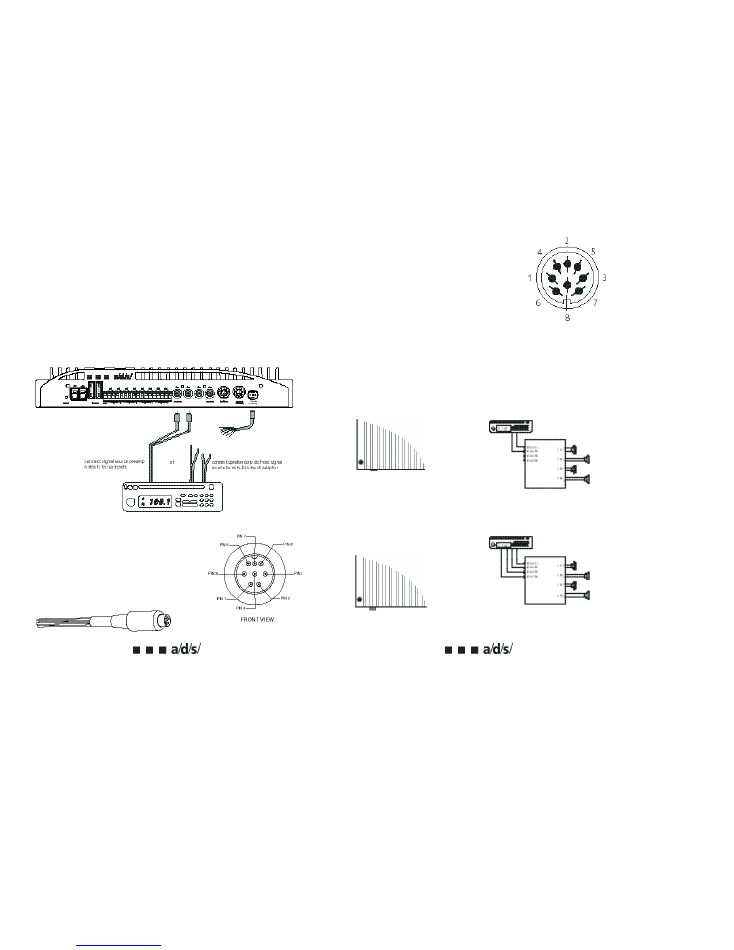
13
14
signal sources
Due to the wide input level adjustment range, all a/d/s/ PowerPlates
TM
can be driven with either a
conventional preamplifier drive signal or the amplified signal from a powered source unit. This
makes the PowerPlate
TM
perfect for upgrading an OEM (Original Equipment Manufacturer) stereo
system while retaining the factory installed radio.
Because of the high impedance of the a/d/s/ input stage, the factory radio drives an easy load. This
ensures lower distortion levels than if it was driving speakers or a Line Output Converter accessory.
As a result, a high quality factory installed radio can deliver high quality sound which is nearly as
good as the sound from a high-end aftermarket source unit. The speaker outputs of the factory
radio are simply connected to a mini-DIN adapter as shown below. From this point on, the signal
can be treated exactly as you would a preamp-level signal, except that the input level controls on
the PowerPlate
TM
will be set to a lower than usual level when you make your final adjustments.
Conventional aftermarket sources may be connected using standard shielded RCA cables from the
source unit’s preamp outputs to the PowerPlate
TM
inputs.
Note: When using 4 channels of input, be sure to configure the 2ch/4 ch input switch to
4ch input. Failure to do so may result in damage to the source unit.
High-level MiniDin input connections:
Pin
Wire Color
Connects to Head Unit
1
gray
front right +
2
violet/black
rear right -
3
white
front left +
4
gray/black
front right -
5
white/black
front left -
6
green
rear left +
7
green/black
rear left -
8
violet
rear right +
Channels 3-8 can be accessed through the din 3-8 connector by using the optional AC202 RCA to
DIN adapter.
DIN ch 3-8 connections:
pin 1
ch 6
pin 2
audio signal ground
pin 3
ch 4
pin 4
ch 5
pin 5
ch 3
pin 6
ch 8
pin 7
ch 7
pin 8
remote power control
AC202 RCA audio inputs are color-coded as follows:
white
ch 3 & 4 input
blue
ch 5 & 6 input
yellow
ch 7 & 8 input
Note: ch 1/2 input not available through the DIN.
internal signal routing
The 2-channel/4-channel input switch routes RCA input from channels 1/2 to channels 3/4. When
the switch is engaged, channel 1 input is routed to both amplifier channels 1 and 3 with input
channel 2 routed to amplifier channels 2 and 4.
Switch in the engaged position.
When the switch is disengaged, channels 1, 2, 3,
and 4 receive signal individually from their respec -
tive inputs.
Switch in the disengaged position.